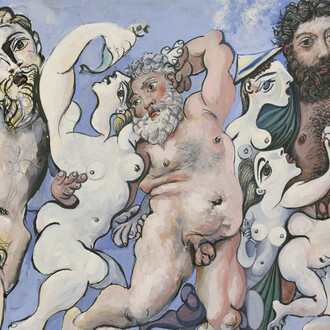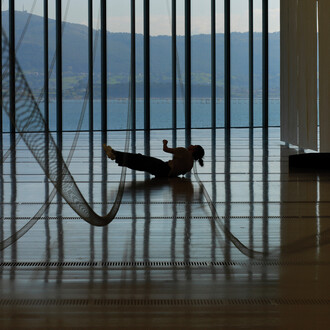The Fernando Pradilla Gallery presents the second solo exhibition of Álvaro Barrios (Cartagena de Indias, Colombia, 1945). This time, the artist is showing his project, The multiplication of paintings. It is a selection of works on canvas produced between 2013 and 2025 that reflect his interest in appropriationism and mass-produced image reproduction techniques. It is also a tribute to the great artists he admires, such as Marcel Duchamp and Picasso. On this occasion, the artist is showing his project The Multiplication of Paintings. This is a selection of works on canvas created between 2013 and 2025 that reflect his interest in appropriationism and mass-produced image reproduction techniques. It also represents a tribute to the great artists he admires, such as Marcel Duchamp and Picasso.
Barrioz is one of the most important artists on the Colombian scene and enjoys international acclaim. His work is represented in the collections of MoMA in New York, the Museum of Contemporary Art in Chicago, and the Daros Collection in Zurich, among many others. As a child, he attended the Biffi-La Salle school in Barranquilla, where he received a Catholic education guided by European teachers. His arrival at the public University of the Atlantic marked his first encounter with Barranquilla's intellectual groups and his first readings of French existentialists and Beat poetry. These were the years in which he came into contact with the founder of the Nadaísta literary group, Gonzalo Arango, and other artists such as Edgar Negret and Norman Mejía. He also met with Enrique Grau, Cecilia Porras, and Alejandro Obregón, then director of the School of Fine Arts, where Barrios held his first exhibition in 1966.
In 1967, he held a solo exhibition at the Museum of Modern Art in Bogotá (MAMBO), invited by Marta Traba, whose circle included artists such as Bernardo Salcedo and Beatriz González. During these years, he made a long trip to Europe, which was an initiatory experience for the artist, as he came into contact for the first time with a work by Marcel Duchamp at the Peggy Guggenheim Museum in Venice. This discovery of European culture, of ancient masterpieces and the 20th-century avant-garde movements, from surrealism to nouveau realism, led Barrios to change his vision of art and focus it on the approaches of conceptual art. “My first contact with Duchamp was through a book without images, Conversations with Pierre Cabanne, in the form of an interview. It reflects Duchamp's main ideas, and I was deeply impressed by his entire theory regarding art, the world, and other artists. I didn't find him iconoclastic or rebellious, but rather profound, and it sparked my interest in prioritizing ideas over forms.” [A.B]
Marcel Duchamp's works thus become recurring material for Barrios's work, in what he himself has defined as a "reciprocal readymade," which María Belén Sáez de Ibarra, in her text for the exhibition The legend of dreams. A review of the work of Álvaro Barrios, defines as follows: "In the self-portrait as Duchamp as Rose Selavy, Barrios establishes a dialogue of successive and double appropriations... The game of appropriation shatters the notion of art, strips works of their possible aura, and breaks the thread that ties them to the dominion of their author. It is an act of insurrection."
His religious understanding of the world also changed after his European tour, and he began to take an interest in other spiritual paths such as esotericism, spiritualism, and Madame Blavatsky's Theosophy, which also influenced some European avant-garde artists. What began as a game became a fundamental activity for his work. Back in Barranquilla, he met a medium who helped him get in touch with his “spirit guide,” in the same way the Surrealists had already experimented in Europe. Together with other artists interested in the occult, they formed the Center for Psychic Research. “We met once a week at night to investigate, through psychic experiences, the great questions that art poses. In these sessions, I discovered my ‘speaking mediumistic faculty,’ through which we tried to find answers to everything related to our doubts. It served as a guide for our own work.” [A.B]
In the 1970s, he served as a professor at the Faculty of Architecture of the University of the Atlantic and at the School of Fine Arts in Barranquilla. In 1971, he conceived one of his most emblematic works, The Caribbean Sea, for the 7th Paris Biennial. This is an installation composed entirely of square silkscreens, blue on one side and red on the other. Each square represents a fragment of the Caribbean Sea as illustrated on maps, delimited by their latitudes and longitudes. This work, now titled The Sea of Christopher Columbus, of which three copies exist, was recently acquired by the Museo Reina Sofía in Madrid; the other two copies are in the collections of the Museum of Chicago and the Pérez Museum in Miami.
This decade of the 1970s was particularly fruitful and laid the foundation for his artistic career. Just a year after El mar del Caribe (The Caribbean sea), Barrios became interested in large-scale reproductions of artworks and created the concept of his Grabados populares (Popular prints). A popular collective action in which the artist inserted advertising drawings into high-circulation newspapers, which, after being collected by the public, were signed and numbered by the artist at a specific location and date. The publication of popular prints was a practice that Álvaro Barrios continued to develop throughout his career. On the occasion of this exhibition in the Fernando Pradilla gallery, the ABC Cultural Museum will include one of them, which the artist will sign on Saturday, September 13, at the same gallery.
Álvaro Barrios's work blends images from both popular culture and art, as well as tributes to the great artists of history: “In 1991, I saw the exhibition High and Low, Modern Art and Popular Culture at MoMA, and I realized the relationship between them and how they feed off each other. Picasso, for example, when addressing a formal problem, relates to caricature. He is the great creator of forms and was nourished by caricature, African art, and newspapers.” [A.B]
In this exhibition at the Fernando Pradilla gallery, we will encounter several large-format paintings and canvases that draw on Barrios's ideas: repetition, appropriationism, and the use of images and techniques typical of multiple works, such as silkscreen printing. Referring to them, the artist explains: “In large-format paintings, I still consider myself a draftsman and a conceptual artist, not a painter, because they deal with flat lines and colours. I have great respect for painting and for great painters. I am interested in all art in any medium, conventional or not, as long as there are important ideas to express and convey, including, of course, painting.” [A.B]
(Sources: Banco de la República Collection. Texts by María Belén Sáez de Ibarra and video of the conversation with Álvaro Barrios)











![Saul Steinberg, The museum [El museo] (detalle), 1972. Cortesía del Museo de Arte Abstracto Español](http://media.meer.com/attachments/dfbad16c22c5940b5ce7463468ac8879f3b4bf23/store/fill/330/330/042ecf3bcd2c9b4db7ddbc57cb32e950c095835f7b5cd55b6e1576a6e78c/Saul-Steinberg-The-museum-El-museo-detalle-1972-Cortesia-del-Museo-de-Arte-Abstracto-Espanol.jpg)


